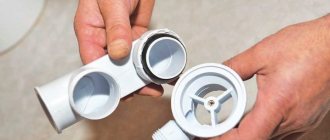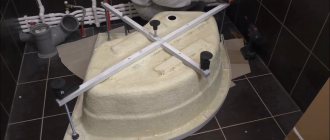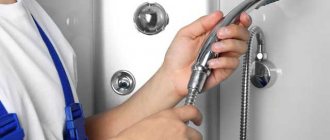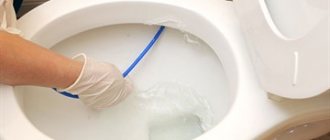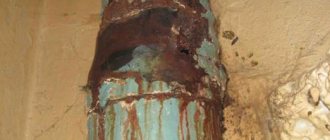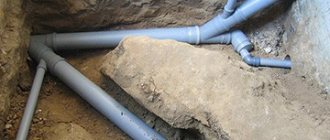The presence of an unpleasant odor from the shower drain indicates the absence of a water seal. That is, about incorrect installation of the drain siphon. You will have to crawl under the cabin and reinstall the siphon. It must be mounted so that the horizon of the water sink is completely filled with water. Otherwise, in addition to the unpleasant odors of the communal sewage system, entire armies of pathogenic bacteria and pathogenic fungi begin to penetrate into the apartment.
If you have a siphon under the pan, then you need to take measures to clean and rinse it.
Apparently the fat and dirt accumulated in it are actively decomposing and bacteria are multiplying, as a result of which you feel an unpleasant odor, so you need to use cleaning agents, something like mole or mechanically disassemble and rinse/clean the siphon.
If you do not have such a siphon, and the drain of the shower stall is made directly into the riser, then such a siphon must be installed, otherwise you will continue to smell odors from the sewer.
What to do if it is not possible to install a siphon, then the second option is to use a plug to close the drainage hole when the shower stall is not in use, thus minimizing the entry of odors into the room.
By the way, many people have this problem due to the impossibility (lack of space) of installing a siphon under the shower tray; people connect the drainage directly, and put a valve on the neck instead of a standard grille.
It is very convenient, the principle of operation is like a stopper in a thermos, double pressing, pressed open, pressed closed, just stepped on and the drainage opened, stepped on again after taking a shower and the drainage is tightly closed with the stopper.
Users of shower cabins often encounter this problem: after taking water procedures, the liquid leaves the tray very slowly.
The reasons for this can be completely different: a clogged siphon, a common sewer, or an incorrect installation of the cabin.
All these factors can lead not only to poor drainage, but also to the appearance of an unpleasant odor. In our article we will talk in detail about the reasons for slow drainage, as well as how to remove the blockage and clear the drain in the shower without consequences for the plumbing. After all, the use of aggressive chemicals can damage the siphon and pipes .
Where does the smell come from?
In order to understand why the shower smells like sewer, you need to understand the general structure of the sewer system. This is a system of pipelines through which liquid moves by gravity. The drains are not under pressure, so most of the time the pipelines are empty. This allows sewer gases produced by organics and other components of liquids to spread freely.
Any change in gas pressure in the system contributes to their release into the atmosphere. When there is a sewer smell from the shower stall, it means that gas is passing through the drain hole - the drain. This is the only possible option, since the cabin is not connected to the sewer anywhere else. Trying to find the cause in other nodes or elements is pointless.
Siphon, water seal
The smell of sewerage from the drain indicates a connection between the cavity of the pipelines and the atmosphere of the house. This should not be allowed, since gases not only deprive apartment residents of comfort, they have a harmful effect on people’s well-being. A siphon is used to isolate the cavity of the system and the atmosphere of the house. This is a bend in the outlet pipe that constantly contains water. It forms a water seal - a kind of plug that does not allow air to pass from the sewer into the apartment (and vice versa).
The smell of sewage from the shower indicates the presence of one of two reasons:
- improper operation of the water seal;
- absence of a siphon (and, accordingly, a water seal).
Many apartment owners or careless plumbers do not install a siphon at the outlet. The shower stall is not yet a very common element, so not everyone can install it correctly. Moreover, if the device is connected by an invited specialist. He won’t have to wonder why the shower smells like sewage. Often the height of the cabin simply does not allow the installation of an incorrectly selected ladder (exhaust element), so its design is changed. At the same time, many consider making a water seal an optional item. A regular corrugation is connected to the drain hole, which is connected to the sewer. At this point the issue is considered resolved. True, after a while questions arise - why does the new shower smell like sewage and how to fix it.
Why does the water seal sometimes not work?
Incorrect operation of the water seal can be caused by two reasons:
- The height difference in the siphon is too small. The water plug is too small, so even a small pressure in the sewer can squeeze it out;
- significant loads on the water seal caused by large pressure drops in sewer pipes.
The first option is most often found on imported shower cabins. They are designed for use in a private house where the sewer riser is not very long. When using the system, significant pressure cannot occur.
The second option is typical for apartment buildings. When multiple toilets or bathtubs are flushed at the same time, strong negative pressure builds up in the riser. It pulls the water seal inside the pipe and often breaks it. Hence the smell of sewage in the shower stall.
There is another option for gas getting out of the system. When the pressure in the pipes increases, it can bubble through the water seal. At the same time, the water plug will not necessarily break; gas bubbles will simply pass through the siphon and enter the apartment.
The main reason for such problems is poor functioning of the drain pipe. It is sometimes clogged with debris or frost, causing the internal cavity to lose connection with the atmosphere. Sometimes residents of the upper floors, not understanding its purpose, simply cut off an unnecessary piece of pipe. As a result, any drainage of water changes the pressure in the riser. After this, the appliance with the smallest and weakest water seal will begin to smell like sewage. Usually this is a bath or shower.
Also read: The toilet on the top floor smells like sewage: why does it smell and what to do?
Causes of odors from sewer pipes
Musty air in the bathroom can occur not only because there is a wet rag lying around somewhere. We are talking about the smell that comes from the pipes. There may be several reasons for the appearance of an unpleasant odor from the pipeline.
This:
- malfunction of the water seal (siphon);
- contaminated pipes - in this case it is necessary to clean them;
- unreliable fastenings of connecting elements.
Some mask the unpleasant smell from the sewer using air fresheners. However, this is only short-term help; the situation will get worse over time. Therefore, it is imperative to find out the cause of the problem and eliminate it - only in this case will you be able to get rid of it. Therefore, regarding the question “there is a smell from the pipes, what should I do?” All that can be said is to find out why this is happening.
Why does water drain poorly?
To find the right method to solve the problem, you must first determine the main reason for the stagnation of water in the pan.
Long corrugation
When connecting a shower stall to a sewer, the siphon is often connected to the main riser using a corrugated pipe. In this case, it is very important to choose the length of the corrugation such that it does not sag .
But some inexperienced plumbers ignore this point and install a pipe that is too long.
Over time, it can further bend, thereby forming a second siphon. It will be very difficult for water to overcome it, so the drainage speed will decrease significantly.
To cope with this problem, you need to replace the corrugated pipe with a shorter one. You can also place bars or bricks under it so that it does not sag.
The most optimal solution to the problem of the second siphon is to replace the flexible corrugated pipe with a rigid, smooth one.
Incline
Often, liquid goes down the drain slowly due to the fact that the angle of the drain pipe is not maintained. As a rule, pipes with a diameter of 50 mm are used to lead shower cabins to the sewer.
For them, it is recommended to maintain a slope of 3 cm for each linear meter of pipe length . If your figure is lower, or the pipes are generally laid horizontally, you need to provide a steeper slope. But how to do that?
The problem is that it is not always possible to physically implement the slope. Very often, the shower siphon is located at the level of the socket of the general sewer system. That is, when they are connected, a horizontal section is obtained. In this case, there is only one way out - you need to raise the shower stall so that the siphon is higher and the drain gets the desired slope.
Unpleasant odor from flexible shower
Forum / Houses, cottages / Unpleasant smell from flexible shower Ask your question on our forum without registration
and you will quickly receive an answer and advice from our specialists and forum visitors! Why are we so sure of this? Because we pay them for it!
Find out details
Maya August 17, 2021 at 3:19 pm Tell me who has encountered or knows how to fix the problem. We didn’t use the flexible shower in the bathroom for a while, we just didn’t turn on the water - there was no need. Now, when you turn on the water through the flexible shower, there is a terribly unpleasant sewer smell. The water drains for 2-3 minutes and the smell goes away, but the next time you turn it on it appears again.
What to do if there is a sewer smell coming from the drain?
It may be that you regularly clean the room, fill the plumbing with chemicals, but this does not help. And the unpleasant smell of sewage from the drain is still present, how can you remove it?
If the technology is violated, an unpleasant odor may come from the pallet. In some cases it can be eliminated.
To fix the problem, you need to find out where it is coming from.
Why does the shower smell like sewer? The most common reason is improper plumbing design. If the siphon is installed according to the rules, then the water will go into the sewer, and a small part will remain in the pipe. This creates a water seal that prevents unpleasant odors from filling the apartment. When there is no water seal, the sewer smell goes directly into the bathroom.
Don't ignore the unpleasant smell of sewerage. Even if it does not affect your mood and general condition in any way, you need to remember that it is harmful to your health. Hydrogen sulfide and ammonia can have a detrimental effect on the respiratory tract.
What are the dangers of sewer smell?
A spoiled mood, unpleasant-smelling towels or laundry drying in the bathroom are not the only unpleasant consequences of a “bad aroma.” The other side of the “tasteless coin” is much more dangerous: air, which contains ammonia, methane, hydrogen sulfide and other dangerous compounds. Inhaling such a flammable mixture provokes irritability, anxiety, insomnia, and an unreasonable feeling of complete weakness.
Prolonged contact with hydrogen sulfide can cause pathologies of the respiratory system, including rhinitis and bronchitis. Another potential danger is vapor poisoning. Its signs are dizziness, headache, nausea, decreased blood pressure. Ammonia can cause vision problems, methane can provoke oxygen starvation of cells, and problems with the autonomic nervous system.
For these reasons, when strange, unusual “odors on the contrary” appear, the owners should immediately “ring the alarm.” You need to find out in advance how to eliminate sewer smell in the bathroom. Awareness will give you a chance to deal with the problem as quickly as possible, otherwise the negative consequences due to the growing concentration of gases will definitely make themselves felt. Such fumes are especially dangerous for children and elderly people with high blood pressure; they are harmful to healthy people and pets.
How to deal with unpleasant odor
Let's look at how to eliminate sewer smell in a shower stall. There are three options for resolving the issue:
- installation of a deeper siphon with an increased water seal;
- installation of a sewer valve;
- restoration of the drain pipe.
First of all, you need to find out exactly why the shower smells like sewer and what to do to fix the problem. It is necessary to check the condition of all system components:
- inspect the shower siphon. If it is too small (or absent altogether), you need to purchase a new, more efficient one. At the same time, you need to measure the distance from the outlet to the floor so as not to buy an element that is too large;
- The sewer valve can be installed on the existing system directly in the apartment. To do this, you need to insert an outlet into the pipe gap to which the valve is connected. It must be borne in mind that it can only solve the issue at low pressure in the system. If it is excessive, gas from the sewer will still flow into the apartment;
- restore the condition of the drain pipe. Here the issue can only be resolved with the help of the management company’s employees. The riser is a common property of the house; unauthorized interference with its operation is not allowed.
Installing a new siphon or sewer valve is not very difficult and can be done with your own hands. In addition, it is useful to periodically carry out preventive maintenance of the drain fittings. It is necessary to clean it of residual fat, hair and other deposits. They decompose and also emit an unpleasant odor. For cleaning, various compositions are used that are sold in hardware stores.
How to fix it at home?
What to do if the shower drain is clogged? Below we present 4 of the most effective methods, which very often help with the formation of a blockage:
plunger
A plunger is one of the simplest devices for cleaning plumbing drains. It is found in almost every home.
To remove a blockage with a plunger, before using it, you need to lubricate its edges with Vaseline - this will help the suction cup better adhere to the plumbing fixtures.
How to use it correctly? If the shower stall is dry, fill it with a little water so that it covers the head of the plunger. Its valve must be positioned so that the edges are completely adjacent to the surface and the drain is closed.
Place the plunger at a slight angle to allow air to escape from the siphon. After all the preparatory stages, you need to make about 20 back-and-forth movements up and down. When you have removed the fixture, run hot water and flush the drain hole - this will help remove any remaining debris.
Disassembling the siphon
If the previous option did not help, you can disassemble the shower siphon. In general, it is recommended to clean it not only when you have a problem with draining water, but also for prevention 4-6 times a year.
Cleaning and disassembly instructions:
- place a container under the drain to collect all the dirt and remaining liquid;
- remove the shutter nut, and then the flask itself;
- wait until all the water has flowed out of the water seal, then remove dirt from the pipe and remove plaque from the walls of the plumbing;
- rinse the elements under running water;
- put the siphon in place and make sure that the water drains normally.
Plumbing cable
If the water drainage is still poor, then the blockage has formed deeper and you need to use a plumbing cable. Cleaning the drain hole with its help is quite simple. The cable can be made from improvised materials, but it is better to buy it in a specialized store.
It is advisable not to insert the cable directly into the drain hole. For convenience, it is better to remove the siphon and work with the sewer pipe outlet.
Video
We have prepared for you an interesting video on how to clear a blockage using a modern plumbing cable and drill.
To ensure that water flows normally into the drain and there is no unpleasant odor, clean the pipe using the method that suits you best. Don’t forget to clean your pipes four to six times a year as a preventative measure. To reduce problems with water drainage, buy a drain mesh. It blocks most of the debris that may end up in the siphon.
There are a number of reasons for an unpleasant odor coming from the opening of the shower stall.
The unpleasant sensation of volatile odors is often caused by gases from the drain that flow back into the shower drain. In addition, the exhaust fan may not be working properly. If the unpleasant sensation of smell is not caused by one of these problems, the presence of odorous substances not coming from the drain may in fact be a separate problem in the bathroom.
Causes
There are 3 main causes of blockage.
1. Debris and hair. After each shower, your hair, threads from clothes, and pet hair get into the drain, and it gradually becomes clogged.
Even if you carefully monitor the cleanliness of the bathroom, this is inevitable. After some time, the debris clumps together and forms a blockage, which complicates the drainage of water from the pan.
2. Small items. Sometimes it happens that small objects fall into the drain hole: stones from jewelry, pieces of gel polish, or something from the floor. Such things do not pass down the siphon and interfere with the outflow of water.
3. Grease and soap residue. Deposits of grease and soap accumulate on the walls of the sewer. Over time, the layer of dirt grows, debris sticks to it, and water begins to flow worse.
Condensation Formation
The reason for the formation of condensation on sewer pipes is the difference in temperatures outside and inside the pipe. Because of this, mold and mildew may appear in places where condensation accumulates, causing an unpleasant odor. In addition, they are also very harmful to health. The fungus appears in rooms with high air humidity, and it is extremely difficult to get rid of it.
This problem can be avoided if you constantly monitor the condition of the pipes. If condensation is detected, the pipeline should be wiped and insulated (for more details: “How to remove condensation from cold water pipes - eliminating causes and consequences”). Thanks to this, in the future there will be no large temperature difference, and therefore the formation of wet marks.
The pipes should be located in such a way that they are easy to reach. If they are located in a place where access is difficult, eliminating the problem will become problematic. The slightest crack in a pipe can lead to the need to dismantle a large part of the room to get to it.
Problems with siphon and water seal
The main problems associated with improper operation of the water seal and siphon are:
- Noticeable sagging of the corrugated pipe. The material from which the corrugation is made means that over time the product will lose its elasticity and other qualities, which is why problems will certainly arise in the future. This does not depend on the quality of the pipe - any corrugated products will begin to sag over time. This is inevitable, and sooner or later the corrugation will have to be replaced.
- If the siphon was installed incorrectly, difficulties may also arise during operation. This problem is often encountered by those who decide to carry out sewer work on their own, without the help of professional plumbers. This is due to the fact that installing a siphon requires compliance with certain rules, and the slightest mistakes can lead to problems.
- It is recommended to listen to the sounds of water flowing down the drain. An incomprehensible rustling or gurgling sound is a sign of a broken water seal. This indicates that there is no water in the device, which prevents odors from the sewer from entering the house. In addition, a vacuum plug may form in the riser. Therefore, if you suspect a malfunction of the water seal, you should take immediate action - if you do not fix the problem with the siphon, the smell from the sewer pipe in the bathroom will constantly come out. Read also: “How to clean pipes at home and what is best to use for this.”
Classification and types of equipment
The siphon ensures the unhindered flow of dirty water and blocks unpleasant odors. The installation consists of a curved pipe.
It is the bending of the pipeline that helps retain some of the water that comes from the pan. Water accumulated in the curved segment prevents unpleasant odors from entering the room.
There are different types of siphons. But, taking into account the differences in design, they can be divided into 3 main types:
- bottle;
- tubal-knee;
- drain drain
The occurrence of hidden or obvious leaks
The formation of a small puddle on the floor indicates an obvious leak that can be quickly noticed and eliminated, but if the kitchen or bathroom is densely packed with furniture and plumbing equipment, it is difficult to determine both the leak and the cause of the smell. There is only one way out - check all the pipes and connections by moving objects away and using a flashlight. To be sure, you can use a paper napkin: even if you don’t visually notice the leak, a wet spot will remain on the napkin.
A leak in the bathroom or kitchen causes inconvenience not only to the owners, but also to the neighbors.
They fix the problem in the traditional way: they change the pipes and seal the connections so that the system becomes completely sealed. And to prevent such unpleasant situations, preventive measures are used:
- monitor the waterproofing of walls and floors;
- use a minimum of joints when installing pipelines;
- pipe connections are made accessible;
- purchase good quality pipes and plumbing fixtures.
By completing these simple steps, you won’t have to wonder how to get rid of sewer smell.
Ways to eliminate unpleasant odor from sewers
If there is a smell from the pipes in the bathroom, what to do:
- If the corrugated pipe sag, you should use clamps. They will bring the pipe into its natural position, and this will help remove the unpleasant odor.
- If the bathroom plumbing will not be used for some time, it is recommended to pour a small amount of vegetable oil into the drains. It will create a film that will prevent water evaporation.
- If pipes become depressurized, the joints should be lubricated with sealant.
- If the pipeline is clogged, a plunger or a special cable can help.
These methods are mechanical ways of eliminating the problem. You can also use special tools, for example, “Mole”, “Domestos”. These compounds are quite effective, but they can destroy rubber seals in pipes.
Why is the water seal broken?
There may be several reasons for this phenomenon, so it is important to consider each case separately:
- The most common reason is improper installation of the siphon. If an ordinary product is installed that looks like a flask, where the pipe is not provided for lowering into the water inside the siphon, then most likely there will still be an unpleasant odor. It easily passes between the water and the walls of the device, thus freely entering the room. To prevent such a situation and make the water retain unpleasant odors again, you just need to lower the pipe into the water a few centimeters lower. Only it should not fall so that it rests against the bottom of the siphon.
- The problem may arise due to sagging of the corrugated tube. If you bend the elbow correctly, the corrugated tube will retain a certain amount of water at the lower level. As a result, the required water seal will be created in the system. After some time, the corrugation loses its rigidity and begins to sag, as a result of which the water level decreases and the water seal disappears. To prevent this situation, you can use special clamps that hold the tube in the correct position for a long time. You can also use regular electrical tape, which can be used to tie the tube as it should be.
- Often an unpleasant odor occurs due to fumes emanating from the siphon. As a rule, this happens due to long downtime of sewerage devices. If the system is not used, the water from the siphon will simply evaporate, and the water seal will break. Many owners of houses and apartments are interested in how to remove this smell and what measures can be taken to prevent this situation? Everything is much simpler than it seems at first glance. Before a long trip, it is recommended to pour a little vegetable oil into the drain hole of the plumbing fixture. Thus, due to the formation of a special film, water will not evaporate from the siphon. If such an incident could not be avoided, then you just need to drain more water to flush the siphon that has accumulated sewer odor.
- Installation errors or savings can also cause unpleasant odors. Illiterate professionals can overstretch the corrugated pipe or secure it in the wrong condition, which will result in a broken or missing water seal. In such situations, a bad smell appears immediately after the installation of new plumbing fixtures.
What else could cause unpleasant odors from the shower?
In fact, not all of the reasons for this problem are listed above. It is also worth noting a small leak in the sewer system, which supplies the same place in the bathroom with moisture. This may cause a musty or rotten smell. There may be a crack in the pipe from which the stench will escape into the room, bypassing the water seal.
checking the drain in the shower stall
A simple reason is the usual clogging of the siphon, which causes stagnant dirt and grease to accumulate.
Often the cause of the problem can be the plumbing fixture itself, especially if it is new and inexpensive. It should be noted that acrylic products can resemble a sewer smell, so it is important not to confuse them. If a good repair has been made, new plumbing fixtures have been installed, then most likely this is the situation that needs to be considered. This feature is explained by the fact that unscrupulous manufacturers of plumbing products use low-quality materials in production.
If the problem arose in a private home, then you need to consider the option of improperly laying sewer pipes and directly installing the devices themselves.
Methods to combat unpleasant odors
Of course, all plumbers claim that eliminating sewer smell is possible only with their help, but in fact, you can try to correct the situation with your own hands. The first thing you need to do yourself is to disassemble the siphon, clean it and rinse it under high pressure water. During the washing process, it is recommended to use household chemicals that will not only clean the device well, but also eliminate the unpleasant odor. If the drain is clogged, for example, with hair or other debris, you can clear it using special chemicals.
If the reason is improper installation of the plumbing fixture, then it is more advisable to seek help from specialists.
Smell of sewage on the first floor. Step-by-step instructions for troubleshooting
There is another reason for the smell on the first floor. This is the immediate proximity to the basement or technical subfloor, where the common intra-house part of the sewage system runs, which collects and discharges all wastewater.
The large diameter, slope and fairly high pressure of the water column in the risers provide a high self-cleaning ability for horizontal pipe distribution in the basement. But subject to the tightness of the system.
If this part is depressurized, the pressure drops, and any bag or rag that gets into the sewer through the toilet can become a source around which a blockage forms. And since there is a leak, the waste will seep and accumulate in the basement. The smell of sewage is felt most strongly by residents of the first floor, but the next ones can also get their share.
Removing such a blockage and restoring the integrity of the system with your own hands can be done in a private building, but not in an apartment building.
Fighting odor in a bathroom or bathroom is only effective if there is good exhaust ventilation. Even with a normally functioning sewage system, high levels of humidity can lead to the formation of colonies of fungus and mold, which certainly will not add a fresh aroma.
Siphon bottle
The bottle-shaped siphon is not flexible, its design includes:
- cylinder;
- end cap;
- sewer;
- attached pipe.
When installing a bottle siphon, the drain hole must be above the lower end of the pipe, located vertically.
This allows a lock to be formed in the cylinder. Water accumulates in the flask and creates a plug to block the unpleasant odor. You can clean the siphon after disassembling the system.
Installing a bottle siphon is simple and does not take much time.


